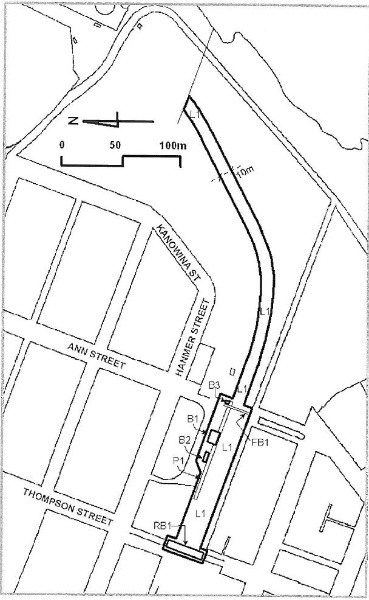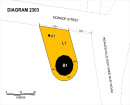WILLIAMSTOWN RAILWAY STATION COMPLEX
17 HANMER STREET WILLIAMSTOWN, HOBSONS BAY CITY
-
Add to tour
You must log in to do that.
-
Share
-
Shortlist place
You must log in to do that.
- Download report




Statement of Significance
What is significant?
The Melbourne Mount Alexander and Murray River Railway Company was formed in 1853 to provide a rail link to port facilities at Williamstown as well as the line north to Echuca, within seven years. The Government took over the faltering project in 1856. An extensive cutting through basalt was required from Newport to Point Gellibrand and arched bluestone road bridges were built over the cutting at Thompson and Cole Streets. A single temporary line led to the pier by 1857, accompanied by the first of three Pier stations. The Railway pier at Point Gellibrand, (VHR1088) which was the terminus of the line, was completed in 1858. By the time of the official opening in 1859 two tracks led past the completed Williamstown Station through the railway workshops and on to the pier. The alignment of these tracks remained amongst a plethora of other lines serving the railway workshops until 1889, and the piers and railway yards until well into the twentieth century.
Builders Kerr, Hodgson and Billings commenced work on the timber Williamstown Station building in 1858. The central section of the station building, which corresponds to the existing building, originally accommodated the lobby, booking, waiting rooms, office and other service rooms. This central bay was flanked by two pavilions with gables facing the street, containing on one side the stationmaster?s residence and on the other refreshment rooms. An ornate timber and iron verandah lined the street side of the station and abutted the side pavilions, while on the rail side the original platform canopy extended along the platform either side of the station. Other timber buildings abutted the station and extended along the bluestone walled and partially stone flagged platform. The verandah, side pavilions and old outbuildings have all gone. A brick toilet block was added in the early twentieth century, and an old timber and iron shed, possibly a lamp room, abuts the foot bridge.
The strap-work truss and timber Ann Street footbridge with cast iron step stringers and columns was installed c1883. A siding, signal box, weighbridge and cabin of later provenance which were located opposite the station, are no longer extant. When the line was electrified in 1916 the Thompson Street road bridge arch was removed and replaced with two composite steel and concrete spans to allow for extra clearance and more lines. The Ann Street footbridge was raised at the same time and has been considerably altered since. The station is still in use but is now the terminus of the line.
How is it significant?
The Williamstown Railway Station Precinct is of Historical and Architectural importance to the State of Victoria
Why is it significant?
The Williamstown Railway Station Precinct is historically significant as the only substantially intact station precinct remaining from the original construction period of the Williamstown line. The Williamstown line was the first Government railway line to be opened in the State. It was a vital early link from Melbourne to the major port facilities, the defensive installations, railway workshops and other government activities at Point Gellibrand, and to the town of Williamstown. The original fabric at the Williamstown Railway Station precinct includes part of the station building and platform canopy, the platform, the abutments of the Thompson Street Bridge, rail alignments and cutting. The station continues in its original use.
The land corridor which once contained the original lines between the Williamstown Railway Station Precinct and the Gellibrand Pier and Time Ball Tower is historically significant as a tangible visual and physical reminder of the important historical link between the Williamstown line and the railway workshop, railway yard and port activities carried out at Point Gellibrand. Most of the physical evidence of the railway workshop and railway yards which formerly occupied this area, and which would otherwise demonstrate this connection, has now been removed.
The Williamstown Railway Station building is of architectural significance as the second oldest railway station in Victoria to survive relatively intact, after the masonry St Kilda Station of 1857.The Williamstown Railway Station building is the oldest timber railway station building to survive in the State. The station building is also one of the one of the earliest surviving timber public buildings in Victoria. The station building possesses an unusual attached hipped-roof platform canopy, which retains much of its original classically inspired detailing. The Thompson Street Road Bridge was also part of the initial works on the line, and the bluestone construction of the abutments is indicative of the stone quarrying industry already established at Point Gellibrand at that time.
The Ann Street foot bridge is of historical significance as an indicator of the ongoing importance of the station and of the need for more convenient pedestrian access over the busy lines.
-
-
WILLIAMSTOWN RAILWAY STATION COMPLEX - History
Contextual History:
In 1851 engineers Amman and James Blackburn had suggested various means of connecting the deep-water port facilities of Williamstown with Melbourne. A prospectus to form a public company top build a railway was issued in 1852. The Melbourne Mount Alexander and Murray River Railway Company was incorporated under an act of Parliament in 1853. As well as the link to Echuca, it was to provide the link to Williamstown within seven years, or the undertaking would be vested in the government. In the meantime, the line from Newport to Geelong was started in 1853, and completed in 1855. A spur line was taken down North Road to a small jetty in the Greenwich reserve to establish a temporary connection by ferry to Melbourne. Work on the embankments for the Railway pier, which was integral to the proposal for the branch line from Melbourne, began around the end of 1854.
Progress was very slow on the Williamstown line and the Company was bought out by the Government in 1856. Tenders were called for contracts for completion of the line in May of 1856. The mile long cutting through the basalt between Newport and Point Gellibrand was largely completed by January 1857, but the laying of line was considerably delayed. The timber extension of the Railway Pier was begun in 1857 and finished in 1858. The main line was extended temporarily to this pier, and the first Pier Station, in October 1857. The first Government railway in the State was officially completed in 1859 under the supervision of Engineer in Chief George C. Derbyshire, with two tracks running to the Gellibrand (Railway) Pier. An 1856 survey showed a proposal for the line to the line running right over the Gellibrand burial ground, but it had been moved to the north-west to avoid this area.
The Breakwater Pier, begun in 1859, served as a breakwater to protect the Railway Pier but also provided number of sawtooth berths to which rail access was added. The railway workshops, between the Williamstown Station and the Piers, were started in 1857 and operated until 1889, when the area was occupied by railway goods yards, grain stores. The opening of the Williamstown line was very important for the development of Williamstown as a port and as a focus for defence activity.
The passenger terminus of the line, the Pier Station, was constructed in 1857 at the landward end of the Railway Pier opposite the pier master’s house. This station was moved to the north west in the 1880s, and again to the edge of Morris (now Kanowna) Street in 1905. No surface remains of any of the first two, and very little of the last station remain.
The first Victorian Government Railways train left Spencer Street station on 13 January 1959 and wqas greeted enthusiastically on its arrival at Williamstown Station. Thompson Street Bridge was decorated as a triumphal arch with flags, flowers, foliage and banners. A flowery arch was erected over the station entrance from the street, with a banner showing a ship under sail and a locomotive, and the words "Advance Williamstown". (L. Harriggan 1962, "Victorian Railways to '62" Victorian Railways Printing Works, Melbourne , p.26)
History of Place:
The tenth contract issued by Victorian Railway was for the building of the Williamstown railway station. Builders Kerr Hodgson and Billings started construction in October 1858. In the documentation the station was described as a temporary building. These drawings show that the original station building incorporated three main sections – station masters residence at the up end, station in the middle, and refreshment rooms and purveyors residence at the down end. The station section was well equipped with facilities which included a coffee room, first class waiting room, ladies waiting room, luggage and lost luggage offices.
The nearby Thompson Street road bridge over the railway was built in 1856, before the station, and was one of the earliest road over rail bridges in Victoria. The bridge in Cole Street, a little further up the line, was constructed soon after. The Thompson Street bridge was constructed in bluestone with a single three centred arch spanning 27 feet (8.23metres) over thesouthern two of the three lines existing today. A set of steps to the south of the northern abutment allowed pedestrian access over the railway line from the station. There were early complaints that the road approaches were too steep and these were extended to reduce the gradient.
The Ann Street footbridge was constructed c1883 and was probably installed because of the business of the line, the growth in numbers and wealth of the Williamstown population, and the inconvenience of making a crossing at the relatively distant Thompson Street bridge.
In 1916 the line was being electrified and the arch of the Thompson Street road was too low to accommodate the system. The altered bridge of two composite concrete and steel spans also provided for a further two lines, though only one was built as late as 1972. The Ann street footbridge was raised for electrification and lengthened at the same time. Increasing activity at the port and yards was manifested in the station area by the addition a siding and weighbridge (with cabin) on the upside, all of which have now been removed, though their earlier presence is still manifest in the extra span of the footbridge.WILLIAMSTOWN RAILWAY STATION COMPLEX - Assessment Against Criteria
Criterion A
The historical importance, association with or relationship to Victoria's history of the place or object.
The Williamstown Railway Station Precinct is historically significant as the only substantially intact station precinct remaining from the original construction period of the Williamstown line. The Williamstown line was the first Government railway line to be opened in the State. It was a vital early link from Melbourne to the major port facilities, the defensive installations, railway workshops and other government activities at Point Gellibrand, and to the town of Williamstown. The original fabric at the Williamstown Railway Station precinct includes part of the station building and platform canopy, the platform, the abutments of the Thompson Street bridge, rail alignments and cutting. The station continues in its original use.
The land corridor which once contained (?) the original lines between the Williamstown Railway Station Precinct and the Gellibrand Pier and Time Ball Tower is historically significant as a tangible visual and physical reminder of the important historical link between the Williamstown line and the railway workshop, railway yard and port activities carried out at Point Gellibrand. Most of the physical evidence of the railway workshop and railway yards which formerly occupied this area, and which would otherwise demonstrate this connection, has now been removed.
The Ann Street foot bridge is of historical significance as an indicator of the ongoing importance of the station and of the need for more convenient pedestrian access over the busy lines.Criterion B
The importance of a place or object in demonstrating rarity or uniqueness.Criterion C
The place or object's potential to educate, illustrate or provide further scientific investigation in relation to Victoria's cultural heritage.Criterion D
The importance of a place or object in exhibiting the principal characteristics or the representative nature of a place or object as part of a class or type of places or objects.Criterion E
The importance of the place or object in exhibiting good design or aesthetic characteristics and/or in exhibiting a richness, diversity or unusual integration of features.
The Williamstown Railway Station building is of architectural significance as the second oldest railway station in Victoria to survive relatively intact, after the masonry St Kilda Station of 1857.The Williamstown Railway Station building is the oldest timber railway station building to survive in the State. The station building is also one of the one of the earliest surviving timber public buildings in Victoria. The station building possesses an unusual attached hipped-roof platform canopy, which retains much of its original classically inspired detailing.
The Thompson Street Road Bridge was also part of the initial works on the line, and the bluestone construction of the abutments is indicative of the stone quarrying industry already established at Point Gellibrand at that time.Criterion F
The importance of the place or object in demonstrating or being associated with scientific or technical innovations or achievements.Criterion G
The importance of the place or object in demonstrating social or cultural associations.Criterion H
Any other matter which the Council considers relevant to the determination of cultural heritage significanceWILLIAMSTOWN RAILWAY STATION COMPLEX - Permit Exemptions
General Exemptions:General exemptions apply to all places and objects included in the Victorian Heritage Register (VHR). General exemptions have been designed to allow everyday activities, maintenance and changes to your property, which don’t harm its cultural heritage significance, to proceed without the need to obtain approvals under the Heritage Act 2017.Places of worship: In some circumstances, you can alter a place of worship to accommodate religious practices without a permit, but you must notify the Executive Director of Heritage Victoria before you start the works or activities at least 20 business days before the works or activities are to commence.Subdivision/consolidation: Permit exemptions exist for some subdivisions and consolidations. If the subdivision or consolidation is in accordance with a planning permit granted under Part 4 of the Planning and Environment Act 1987 and the application for the planning permit was referred to the Executive Director of Heritage Victoria as a determining referral authority, a permit is not required.Specific exemptions may also apply to your registered place or object. If applicable, these are listed below. Specific exemptions are tailored to the conservation and management needs of an individual registered place or object and set out works and activities that are exempt from the requirements of a permit. Specific exemptions prevail if they conflict with general exemptions. Find out more about heritage permit exemptions here.Specific Exemptions:General Conditions:
1. All exempted alterations are to be planned and carried out in a manner which prevents damage to the fabric of the registered place or object.
2. Should it become apparent during further inspection or the carrying out of alterations that original or previously hidden or inaccessible details of the place or object are revealed which relate to the significance of the place or object, then the exemption covering such alteration shall cease and the Executive Director shall be notified as soon as possible.
3. If there is a conservation policy and plan approved by the Executive Director, all works shall be in accordance with it.
4. Nothing in this declaration prevents the Executive Director from amending or rescinding all or any of the permit exemptions.
Nothing in this declaration exempts owners or their agents from the responsibility to seek relevant planning or building permits from the responsible authority where applicable.
EXEMPTIONS
Building B1:
General maintenance which replaces like with like
Repainting in existing colours
Buildings B2 &B3:
Repainting in existing colours
General maintenance which replaces like with like
All internal works which do not cause a change in the external appearance of the building
Station Platform:
Resurfacing of the platform in asphalt
Installation of lighting (on existing light poles), speakers, monitor cameras, and monitor screens
Ann Street footbridge:
Maintenance works to secure the structure in its current form
All of the railway reserve land:
Reballasting, relevelling or renewal of rail tracks
Removal of, rewiring or restructuring of live wire
Repositioning or renewal of wire support columns
Removal and installation of signals and wiring
Thompson Street Road Bridge:
Resurfacing of road.
General maintenance and repairs which replace like with like
Corridor of former railway line:
Installation of pedestrian paths, interpretive material and low level landscaping which does not alter the levels of the former lineWILLIAMSTOWN RAILWAY STATION COMPLEX - Permit Exemption Policy
The fabric of highest significance in the complex is that relating to the earliest years of the line – the station building and platform canopy, platform and Thompson Street bridge abutments. Of particular importance is the remaining original fabric of the station building. A permit from Heritage Victoria would be required for any works which alter the appearance of any of these.
The elements of the Ann Street footbridge remaining from the Mephan Ferguson Foundry contract are also of high significance. The existence of the footbridge overall as a structure is an important part of the setting of the complex and should be maintained. Works to secure the existing structure should be exempt. Works to make the footbridge serviceable as a footbridge or lookout would involve substantial alterations to render the structure and steps acceptable to current standards, and so a permit from Heritage Victoria would be required.
Other listed built elements in the complex should be retained with their external appearance substantially unaltered as part of the setting of the station complex, but internal works should be exempt.
The need for addition of further buildings or modifications to the platform is unlikely. However, a permit for any new buildings would be required to determine the acceptability of their impact upon appreciation of significant elements of the complex.
The most likely ongoing requirement for works at the station relates to maintenance, renewal and upgrade of the operating parts of the railway such as rails, signals, live wires and wire supports, as well as lighting and monitoring equipment on the platform. None of these elements date from the earliest period of the station, and most have been renewed relatively recently. Comprehensive exemptions are provided for their replacement.
The railway line corridor to railway pier has been registered as an essential part of the setting of the Railway Station, which is significant as the earliest station on the line extending through to the original Pier Station and Gellibrand Pier. The width of this corridor is designed to match the easement typically accorded to an active railway line. The levels of the original tracks should also be maintained. Buildings or main road vehicle access routes along the corridor are outside the intention of the registration of this feature. Pedestrian tracks, associated low level landscaping and interpretive works along the corridor cause minimum impact to the significance and may enhance appreciation of the site and so are exempted from permit requirements.
-
-
-
-
-
FORMER MORGUE
 Victorian Heritage Register H1512
Victorian Heritage Register H1512 -
TIME BALL TOWER
 Victorian Heritage Register H1649
Victorian Heritage Register H1649 -
TIDE GAUGE HOUSE
 Victorian Heritage Register H1513
Victorian Heritage Register H1513
-
"1890"
 Yarra City
Yarra City -
"AMF Officers" Shed
 Moorabool Shire
Moorabool Shire -
"AQUA PROFONDA" SIGN, FITZROY POOL
 Victorian Heritage Register H1687
Victorian Heritage Register H1687
-
'Altona' Homestead (Formerly 'Laverton' Homestead) and Logan Reserve
 Hobsons Bay City
Hobsons Bay City
-
-















